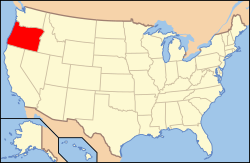Oregon Department of Corrections
| Oregon Department of Corrections | |
|---|---|
 | |
| Agency overview | |
| Employees | 4,404 |
| Jurisdictional structure | |
| Operations jurisdiction | Oregon, USA |
 | |
| Map of Oregon Department of Corrections's jurisdiction | |
| Size | 98,466 square miles (255,030 km2) |
| Population | 3,930,065 (2013 est.)[1] |
| General nature | |
| Operational structure | |
| Headquarters | Salem, Oregon |
| Agency executive |
|
| Facilities | |
| Prisons | 14 |
| Website | |
| Oregon DOC Website | |
The Oregon Department of Corrections is the agency of the U.S. state of Oregon charged with managing a system of 14 state prisons since its creation by the state legislature in 1987. In addition to having custody of offenders sentenced to prison for more than 12 months, the agency provides program evaluation, oversight and funding for the community corrections activities of county governments. It is also responsible for interstate compact administration, jail inspections, and central information and data services regarding felons throughout the state. It has its headquarters in Salem.[2]
Institutions and Community Corrections Offices
The Oregon Department of Corrections operates 16 facilities across the state, with the Oregon State Penitentiary being the only Maximum Security facility.

- Coffee Creek Correctional Facility
- Columbia River Correctional Institution
- Deer Ridge Correctional Institution
- Douglas County Community Corrections
- Eastern Oregon Correctional Institution
- Linn County Community Corrections
- Mill Creek Correctional Facility
- Oregon State Correctional Institution
- Oregon State Penitentiary
- Powder River Correctional Facility
- Santiam Correctional Institution
- Shutter Creek Correctional Institution
- Snake River Correctional Institution
- South Fork Forest Camp
- Two Rivers Correctional Institution
- Warner Creek Correctional Facility
Oregon Department of Corrections Agency History
In 1851, Oregon established its first state-run institution. Oregon State Penitentiary (OSP) was established in 1851 in Portland, Oregon. However, in 1864 funds were allocated to purchase as its in Salem for OSP and an insane Salem. In 1866 OSP was relocated to Salem and encompassed by a concrete wall. OSP is Oregon's only maximum security prison. The capacity of the penitentiary is 1700 inmates. From 1866-2007 the Oregon Department of Corrections opened 13 more correctional institutions.[3] For over a century Oregon sustained with one prison, with the addition of the second prison in 1929 (Mill Creek Correctional Facility) after the state allowed for the entrance of Blacks person in 1926.[4]
In 1929 Mill Creek Correctional Facility (MCCF) was converted from a state training school to a minimum security prison (previously named Annex Farm). This facility is entirely self funded and uses prison labor to produce food form their facility and other ODOC institutions. Eastern Oregon Correctional Institution (EOCI) was opened in Pendleton in 1985 in the form Eastern Oregon Hospital and Training center and as a minimum security prison places significance on rehabilitation. However, Oregon Department of Corrections was not called the Oregon Department of Corrections until 1987 in which its name changed from "Corrections Division". Oregon Women's Corerectional Center opened in 1965, became autonomous in 1972, and was recommissioned in 2002.
Santiam Correctional Institution was opened in 1977 in Salem as minimum security facility. Powder River Correctional Institution was opened in Baker City in 1989. Shutter Creek Correctional Institution was previously an Air National Guard Radar Station in North Bend and was converted to a minimum security labor camp in 1990. Snake River Correctional Facility was opened in 1991. South Fork Forest Camp (SFFC) has used inmate labor to combat forest fires and to assist the State Forestry Department in its reforestation program. Two Rivers Correctional Facility's construction was complete in March of 200; however, ODOC began housing inmates in December 1999. Coffee Creek's minimum security institution was opened in October 2001 and the medium security facility was opened in April 2002. Coffee Creek Correctional Facility (CCCF) comprises Oregon Corrections Intake Center (OCIC) for men and women; in addition, to the states only full service women's prison. Warner Creek Correctional Facility (WCCF) opened in September 2005 and houses 400 inmates. Construction for the institution was delayed in 2001 due to lack of funding and continued in 2003 after funding was allocated. Finally, the states newest prison, Deer Ridge Correctional Institution (DRCI), was established in 2007.[3]
Organization
Office of the Director
Colette S. Peters, Director
The Office of the Director oversees all ODOC divisions while divisions have their own units within them .
Division and units
- Administrative Services
- Community Corrections
- Human Resources
- Operations
Oregon Probation Population Demographics
Race:
- Asian: 160
- Black: 972
- Hispanic: 931
- Native American:218
- White: 12,427
- Pacific Islander: 18
- Total: 14,726
Sex:
- Women:4,298
- Men: 10,476
- Total: 14,774
Age:
- 17 and Under:12
- 18-24: 2,218
- 25-30: 3,331
- 31-45: 5,944
- 46-60: 2,687
- 61 and Older: 582
- Total: 14,774
Oregon Prison/Jail Population Demographics
Race:
- Whites make up 78% of Oregon's state population they consist of 69% of Oregon's prison/jail population.
- Latinos account for 12% of Oregon's state population and 16% of Oregon's prison/jail population.
- Blacks make-up 2% of Oregon's state population and 10% of Oregon's prison/jail population.
- American Indians and/or Native Americans are 1% of the Oregon state population and make-up 3% of Oregon's prison/jail population.
While Latinos, Blacks, and American Indians and/or Native Americans are overrepresented in Oregon's incarcerated population, Whites are underrepresented.[5]
Sex:
- Women account for 1,211 (approximately 8%) of inmates in the Oregon prison population and make up 50.4% of the Oregon state population.[6]
- Men account for 13,512 (approximately 92%) of inmates in Oregon's prison population and make up 49.6% of the Oregon state population.[7]
Age:
- 17 and under:0
- 18-24: 1,267
- 25-30: 2,811
- 31-45: 6,253
- 46-60: 3,556
- 61 and older: 1,036
- Total: 14,923[8]
Oregon Death Penalty
In Oregon's history the death penalty became law four times. On two occasions it was voted out of practice by Oregon citizens and once abolished by Oregon Supreme Court.
Male death row inmates are held at Oregon State Penitentiary. Women on death row are held at Coffee Creek Correctional Facility until shortly before their execution. The execution chamber is at Oregon State Penitentiary.[9] The Oregon Statute Staes:"The punishment of death shall be inflicted by the intravenous administration of a lethal quantity of an ultra-short-acting barbiturate in combination with a chemical paralytic agent and potassium chloride or other equally effective substances sufficient to cause death."[10] The chemicals used to inflict death are Pentobarbital which induces unconsciousness, Pancuronium Bromide which stops breathing, and Potassium Chloride which stops the heart from beating.
As of January 1, 2019 there are 30 inmates on death row (29 men and 1 woman).[10]
Private prisons
The state of Oregon does not use private prisons, and as of 2001 outlawed its former practice of exporting state prisoners to other states.[11][12]
An effort in 1996 had about 12% of Oregon's prisoner population exported to private facilities run by Corrections Corporation of America in Texas and Arizona. The experiment ended after escapes,[13] sexual contact between guards and inmates at Central Arizona Detention Center,[14] and a controversy related to CCA's housing of 240 Oregon sex offenders in a private facility near Houston Intercontinental Airport. Local authorities were only notified of their presence after two had escaped.[15]
Fallen officers

Since the establishment of the Oregon Department of Corrections in 1987, ten officers have died in the line of duty.[16]
Women At Coffee Creek Correctional Facility (CCCF)
The Real Cost of Prisons project highlights that 78% of women in prison in the United States have survived physical or sexual abuse. Additionally, that when who have a history of abuse or neglect as children have a 77% high rate of arrest than that of women who were not abused.[17] Surveys conducted by Portland State University of two-hundred women at Coffee Creek Correctional Facility (CCCF) also report display that many of the women in their facility have also survived domestic violence and childhood trauma. Of the two-hundred women surveyed, 68% of the women who were in relationships relationships when imprisoned, report that they faced physical, mental, and emotional intimate partner violence. In addition, in regard to childhood abuse and trauma 80% of women reported being emotionally abused, almost 70% reported being physically abused, and report being sexually abused.[18]
However, sexual abuse does not end while women are incarcerated. Sexual abuse and rape is not only occurring at Coffee Creek Correctional, but it being ignored by prison staff and those who report it are reprimanded, in accordance to a series of multi-million dollar lawsuits filed against the Oregon Department of Corrections. The Oregon Department of Corrections are being sued by five current and former inmates of CCFI for allegations of rape, groping, assault, and molestation at the hands of a nurse in the medical unit, Tony Klein. Oregon State Police investigation found that Klein had been reported by 11 inmates for some type of sexual contact and was not charged due to accounts being "unreliable". Tony Kleins nursing license with Oregon State Board of Nursing remains active.[19]
See also
- List of law enforcement agencies in Oregon
- List of United States state correction agencies
- Oregon Youth Authority
- Oregon Criminal Justice Commission
- Harry Minto
- Harry Tracy
- Michael Francke
References
- ^ "Annual Estimates of the Resident Population for the United States, Regions, States, and Puerto Rico: April 1, 2000 to July 1, 2008". United States Census Bureau. Archived from the original on July 9, 2009. Retrieved 2009-02-06.
- ^ "Contact Us." Oregon Department of Corrections. Retrieved on December 7, 2009.
- ^ a b "Oregon Department of Corrections Agency History". Oregon State Archives. Oregon State Archives. Retrieved June 1, 2019.
- ^ "Our History". Oregon.gov. Oregon.gov. Retrieved June 1, 2019.
- ^ "Oregon Profile". prisonpolicy.org. Prison Policy Initiative. Retrieved June 1, 2019.
- ^ "Quick Facts: Oregon". census.gov. U.S. Census Beurea. Retrieved June 1, 2019.
- ^ content1"Oregon Department of Corrections Prison Population Trends" (PDF). Oregon.gov. Oregon Department of Corrections. Retrieved June 1, 2019.
- ^ "Oregon Department of Corrections: Quick Facts" (PDF). Oregon.gov. Oregon Department of Corrections. Retrieved June 1, 2019.content1
- ^ "Capital Punishment in Oregon -Statistics ." Oregon Department of Corrections. Retrieved on February 19, 2016.
- ^ a b "Oregon Health Penalty". Oregon.gov. Oregon.gov. Retrieved June 1, 2019.
- ^ Merchandizing Prisoners: Who Really Pays for Prison Privatization?, by Byron Eugene Price, page 99
- ^ Mason, Cody (2012). Too Good to be True: Private Prisons in America. The Sentencing Project. p. 5.
- ^ "Oregon inmate escapes at Ariz. prison". Tucson Citizen. Associated Press. 9 September 1996. Retrieved 25 August 2016.
- ^ "Idaho Prison Contractor Investigated On Sex Charges". The Spokesman-Review. Associated Press. 10 October 1997. Retrieved 25 August 2016.
- ^ "Texas authorities fuming over Oregon inmate escape". Eugene Register-Guard. Associated Press. 10 August 1996. Retrieved 25 August 2016.
- ^ The Officer Down Memorial Page
- ^ Miller-Mack, Willmarth, and Ahrens (2005). Prisoners of a Hard Life: Women & Their Children. Real Cost of Prison Project. ISBN 0-9763856-2-7.
{{cite book}}: CS1 maint: multiple names: authors list (link) - ^ Powell, Meerah. "Report: Majority Of Oregon Women In Prison Faced Abuse Prior To Incarceration". opg.org. Oregon Public Broadcasting. Retrieved June 2, 2019.
- ^ Woodworth, Whitney. "You're not the only one". statesman journal.com. Statesman Journal. Retrieved June 2, 2019.
- "Oregon Department of Corrections - Present Duties and Responsibilities". Oregon Blue Book (Online). Salem, Oregon: Oregon Secretary of State. 2006. Retrieved 2008-12-18.
